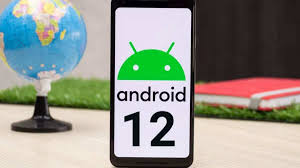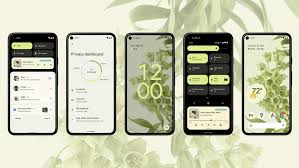



The Latest version of the Android OS is 12, released on October 4, 2021. Of course, unless you’re running a “stock” Android device, you may not have access to Android 12 for quite some time. This is because each device manufacturer tends to develop and put their own custom “skin” on top of Android. For example, Samsung Galaxy phones have One UI, Xiaomi has MIUI, OnePlus has OxygenOS, and so on, which causes the delay.

On-screen elements are more spaced out, and Android 12 takes better advantage of the high-resolution screens that modern phones have. You can also take screenshots that extend beyond the actual screen limits, such as an entire web page as you scroll through it using the scrollable screenshot feature.
Another notable set of features in Android 12 relates to accessibility. There’s a new window magnifier, an extra dim mode for those with light sensitivity or who want to browse in the dark. Depending on your vision needs, you can also bold text across the entire phone and do system-wide color tweaking, including switching the phone to grayscale. Privacy features bring Android 12 more in line with the latest version of Apple’s iOS. There are new clear indicators when your mic or camera is recording, and you can permanently disable your camera and mic if you don’t want any apps to access them.
- *Cupcake (Android 1.5)
- *Donut (Android 1.6)
- *Eclair (Android 2.0 – 2.1)
- *Froyo (Android 2.2 – 2.2.3)
- *Gingerbread (Android 2.3 – 2.3.7)
- *Honeycomb (Android 3.0 – 3.2.6)
- *Ice Cream Sandwich (Android 4.0 – 4.0.4)
- *Jelly Bean (Android 4.1- 4.3.1)
- *KitKat (Android 4.4 – 4.4.4)
- *Lollipop (Android 5.0 – 5.1.1)
- *Marshmallow (Android 6.0 – 6.0.1)
- *Nougat (Android 7.0 – 7.1.2)
- *Oreo (Android 8.0 – 8.1)
- *Pie (Android 9.0)
- With Android 10 (aka “Quince Tart”), Google decided that it would switch over to version numbers just like Apple’s iOS.
- The dessert code names haven’t gone away, but they are no longer the official public name of the operating system. For example, Android 11’s internal codename is “Red Velvet Cake.” Android 12’s dessert name is “Snow Cone”!
If you’re raring to go and want to upgrade to the latest version of Android, there are a few ways to do it. The one that requires the least effort is simply waiting until you receive a notification that your phone is ready for a system update. Then you can simply schedule the update or proceed with it immediately, downloading the update over Wi-Fi.
If you want to check whether an update is available manually, open Settings and select software update.
Then again, companies like Samsung or Xiaomi add features to their custom version of Android that isn’t in the stock Android release or will only come in a future version. For example, a screen recording feature was only added to Android 11, but Samsung Galaxy phones (among others) have had this for years before Android 11’s release.
If your handset is older than two years, you may never receive the option to update your phone. Android phones have a notoriously short support cycle compared to iPhones, and you may find that you’re left out in the cold as they turn their attention to new handsets.
This is changing; for example, Samsung has committed to at least four Android version updates for its Galaxy S22 phone range. If you have a stock Android device such as the Google Pixel 6 or other Pixel phones, you can update as soon as a new Android version drops. However, Android may not support older models because they can’t handle new functionality.
You can also grab a preview build from Google’s Developer site and run it in an Android Emulator to get a taste of what’s to come.
This is an excellent way to update a phone or tablet that is no longer receiving updates but may have competent hardware to run new versions of Android. However, you may face some downsides, such as losing manufacturer-specific features for that device. For example, if you have a fancy foldable phone, it’s unlikely that a custom ROM not meant for that handset would support folding functions.
Flashing your phone with a custom ROM is not for the faint-hearted, but if you follow the steps to root your device install custom recovery software, and finally flash a custom ROM, you should get through it.It is possible to roll back to a previous version of Android, but not using official methods. Instead, check out the guide on downgrading to an older version.
